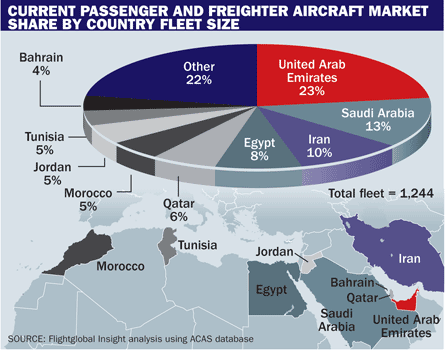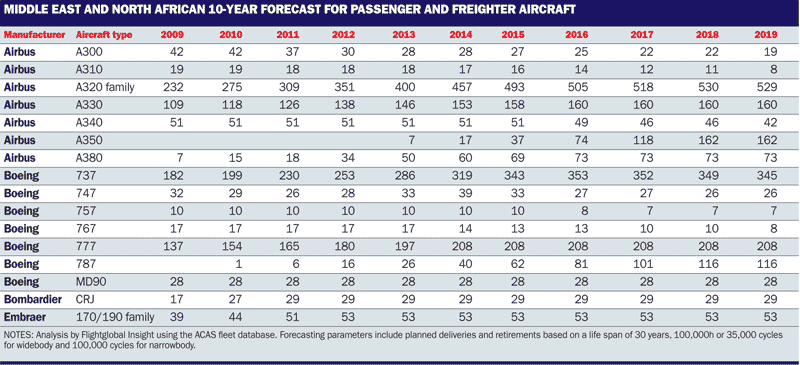Our graph predicting the shape of the Airbus and Boeing narrowbody and widebody fleet in the Middle East and North Africa region between now and 2019 has the pleasing trajectories of aircraft taking off sharply before settling into cruise. The numbers of aircraft in the graph represent a growing feedstock for the region's maintenance providers.
The chart, based on analysis and forecasts by Flightglobal Insight from our ACAS database, shows the steepest climb for Airbus narrowbodies, virtually doubling in number from 214 in 2010 to 432 by 2015, and evening out at around 500 aircraft by the turn of the decade.
 |
|---|
Airbus widebodies are also expected to increase markedly, although the biggest ascent is pushed slightly to the right.
They will grow more modestly from 224 to 320 by 2015, but then - presumably as more A350 XWBs enter service and the A380 hits peak production - soar to 467 by 2019.
Boeing starts off from a lower base in the Middle East and North Africa than its European rival - with 194 narrowbodies and 166 widebodies. The growth of its fleet is predicted to be slower, finishing the decade with 361 and 342 aircraft, respectively.
Our breakdown of the current passenger and freighter fleet by country (which includes active and parked widebody, narrowbody and regional aircraft) shows that the United Arab Emirates - home to two of the region's giants, Emirates and Etihad, as well as a number of recent start-ups - dominates.
Over a quarter of the region's fleet - 284 aircraft - is based in Abu Dhabi, Dubai or one of the smaller emirates.
 |
|---|
Saudi Arabia - the region's richest nation - comes next with 14% or 158 aircraft, although the figures are influenced by the dozens of Airbus- and Boeing-derived private jets. These are the transport of choice for the kingdom's ruling and business elite, as they are around the Gulf, although they predominate in Saudi Arabia.
Next on the list is Iran, a populous country with a large diaspora around the world. However, its 10% share is unlikely to grow as its largely 1970s-era fleet ages and breaks down in the face of economic sanctions from much of the West. The nation has been turning to Russia to meet its airliner needs.
Egypt, another country with a sizeable population and thriving tourism industry, has 8% of the region's fleet, followed by tiny Qatar, whose 73 aircraft are dominated by those of its highly successful flag carrier Qatar Airways.
It is followed by Morocco, Jordan and Tunisia, all with successful national airlines and tourist bases. Bahrain - home to Gulf Air - has a 4% share of the overall fleet.
Source: Flight International



























